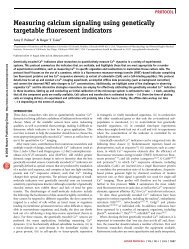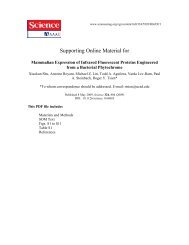THE GREEN FLUORESCENT PROTEIN - Tsien
THE GREEN FLUORESCENT PROTEIN - Tsien
THE GREEN FLUORESCENT PROTEIN - Tsien
You also want an ePaper? Increase the reach of your titles
YUMPU automatically turns print PDFs into web optimized ePapers that Google loves.
528 TSIENa 395- to 475-nm excitation maximum, (c) loss of 488-nm-excited fluorescence,reversible by illumination at 406 nm, and (d ) generation of rhodamine-like orangeor red fluorescence upon illumination at 488 nm under strictly anaerobicconditions (58).IRREVERSIBLE PHOTOBLEACHING Photobleaching is the simplest and mostuniversal behavior of fluorophores. Most GFPs are relatively resistant to photobleaching(22, 59), perhaps because the fluorophore is well shielded fromchemical reactants such as O 2 . The bleach rate of the prototypic class 2 GFP,the S65T mutant, was reported to be relatively indifferent to equilibration with0–100% oxygen or addition of quenchers of triplet states, singlet oxygen, andradicals (59). Nevertheless, with sufficient laser power, photobleaching is easilyobserved and exploited for measurements of fluorescence recovery (37, 59, 60).The class 6 mutants (BFPs) are generally more photosensitive than classes 1–5(28). Cell-permeant antioxidants may be helpful in protecting such GFPs frombleaching. An example is Trolox, 6-hydroxy-2,5,7,8-tetramethylchroman-2-carboxylic acid, a water-soluble vitamin E analog commercially available fromAldrich Chemical Co., Milwaukee, WI.SHIFTING TO A LONGER-WAVELENGTH EXCITATION PEAK This behavior ischaracteristic of wild-type and other class 1 GFPs (11, 22, 36). As discussedpreviously, the mechanism is probably a light-driven proton transfer from theneutral chromophore to the carboxylate of Glu222, yielding an anionic chromophoreand a protonated Glu222 (32). This UV-induced enhancement of theblue excitation peak has been exploited to measure lateral diffusion of GFPtaggedproteins (37). Because the proton transfer is mediated by Thr203 andSer205, mutation of those residues might be a promising way to enhance thisphotochromic effect. Indeed, UV irradiation of the double mutant T203S,S205T increases the amplitude of its long-wavelength excitation peak 11.8-fold, whereas wild-type GFP under the same conditions increases by at most3.6-fold (R Heim, RY <strong>Tsien</strong>, unpublished information).REVERSIBLE LOSS OF LONGER-WAVELENGTH EXCITATION PEAK; SINGLE MOLE-CULE DETECTION The opposite behavior, a shift from a longer to a shorterexcitation wavelength, seems to occur in class 4 mutants. Upon intense laserillumination and observation of the fluorescence from single molecules immobilizedin a polyacrylamide gel, such mutants both blink reversibly on a time scaleof seconds and switch the fluorescence off over tens of seconds (61). However,the apparent bleaching can be reversed by illumination at short wavelengthssuch as 406 nm. Probably the chromophore, which is normally mostly anionic,can eventually be driven into a protonated state with an excitation maximumnear 405 nm, whereupon it appears nonfluorescent and bleached to the probe






